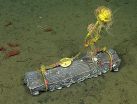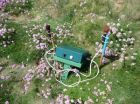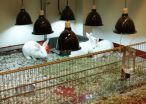(Press-News.org) Oyster aquaculture in the Potomac River estuary could result in significant improvements to water quality, according to a new NOAA and U.S. Geological Survey study published in the journal Aquatic Geochemistry.
All of the nitrogen currently polluting the Potomac River estuary could be removed if 40 percent of its river bed were used for shellfish cultivation, according to the joint study. The researchers determined that a combination of aquaculture and restored oyster reefs may provide even larger overall ecosystem benefits. Oysters, who feed by filtering, can clean an enormous volume of water of algae which can cause poor water quality.
The study is based on data modeling and an ecosystem-wide scientific evaluation, which examined how activities in the watershed affected the river estuary's water quality. The research team evaluated nitrogen flows from the Potomac River headwaters and the nutrient-related water quality conditions of the estuary, called eutrophication.
Eutrophication takes place when a body of water becomes enriched in dissolved nutrients that stimulate the growth of aquatic plants, causing nuisance algal blooms. These blooms often result in the depletion of dissolved oxygen and the loss of seagrasses.
The team sought to assess how shellfish aquaculture – specifically oyster aquaculture -- could be used to remove nutrients directly from the water, complementing traditional land-based measures.
Although the estuary bottom area needed to grow oysters to remove the nutrients exists, it is unlikely that such a management measure would be implemented because of conflicting uses. However, a smaller area could still provide great benefits if aquaculture leases were approved. According to the study, if only 15 to 20 percent of the bottom was cultivated it could remove almost half of the incoming nutrients.
"Our study looked to see just how much impact oyster aquaculture could have in restoring some balance to the system," said Suzanne Bricker, Ph.D., physical scientist in NOAA's National Centers for Coastal Ocean Science and the paper's lead author. "Eutrophication conditions in the Potomac River estuary are representative of conditions found in the Chesapeake Bay and many other U.S. estuaries. Historically, waters of the Potomac and other Chesapeake region estuaries were filtered by oysters, but as their populations declined so did their filtration capabilities. This resulted in increased concentrations of nutrients and related water quality concerns, such as algal blooms and low dissolved oxygen.
"The most expedient way to reduce eutrophication in the Potomac River estuary would be to continue reducing land-based nutrients complemented by a combination of aquaculture and restored oyster reefs. The resulting combination could provide significant removal of nutrients and eutrophication impacts directly from the water column, and offer innovative solutions to long-term persistent water quality problems."
This alternative approach to water quality management has the potential to address legacy pollution, provide a marketable seafood product if there are no other contaminant issues that would prevent human consumption, and enhance local economies with additional income to growers through the possible development of a program -- similar to those being considered in other parts of the country -- where growers would be paid for the water cleaning services done by their oysters.
Flowing into the Chesapeake Bay, the Potomac River is the fourth largest river on the Atlantic coast, with more than six million people living in its watershed. The NOAA and USGS research about human influences on water quality found that the effects of high nutrient levels have not changed overall since the early 1990s. There are, however, some signs of improvement, such as decreased nitrogen loads from the watershed, increased dissolved oxygen and decreased algal blooms in the upper estuary, and continued regrowth of seagrasses.
While scientists have seen signs of improvement, they remain concerned with eutrophication. Dissolved oxygen, a key measure of water quality, is something fish and other aquatic species can't survive without.
Atmospheric deposition — where gases and particles are released into the atmosphere from combustion of fossil fuels and return to the land as contaminants — also plays a role in polluting the estuary.
"Less attention has been paid to monitoring the effects of atmospheric deposition in headwater streams now that acidic emissions have declined because of the Clean Air Act and Amendments going into effect," said Karen Rice, Ph.D., USGS research hydrologist. "Nevertheless, monitoring of forested, headwater streams that reflect changes in atmospheric inputs should be continued, if not expanded, so that changes in stream-water quality as related to atmospheric deposition can be tracked."
The researchers believe the results of the study may be useful on a broad basis, as there are other river-dominated estuaries in the Chesapeake region and elsewhere along the U.S. coastline that could support shellfish aquaculture.
INFORMATION:
USGS provides science for a changing world. Visit USGS.gov, and follow us on Twitter @USGS and our other social media channels. Subscribe to our news releases via e-mail, RSS or Twitter.
NOAA's mission is to understand and predict changes in the Earth's environment, from the depths of the ocean to the surface of the sun, and to conserve and manage our coastal and marine resources. Join us on Facebook, Twitter and our other social media channels.
Oyster aquaculture could significantly improve Potomac River estuary water quality
2014-04-09
ELSE PRESS RELEASES FROM THIS DATE:
Genome sequencing of MRSA infection predicts disease severity
2014-04-09
April 9, 2014 –The spread of the antibiotic-resistant pathogen MRSA (methicillin-resistant Staphylococcus aureus) remains a concerning public health problem, especially among doctors trying to determine appropriate treatment options for infected patients. Bacterial pathogens, such as MRSA, cause disease in part due to toxicity, or the bacterium's ability to damage a host's tissue. In a study published online today in Genome Research, researchers used the genome sequence of MRSA to predict which isolates were highly toxic, thus potentially personalizing the treatment of ...
Farming for improved ecosystem services seen as economically feasible
2014-04-09
By changing row-crop management practices in economically and environmentally stable ways, US farms could contribute to improved water quality, biological diversity, pest suppression, and soil fertility while helping to stabilize the climate, according to an article in the May issue of BioScience. The article, based on research conducted over 25 years at the Kellogg Biological Station in southwest Michigan, further reports that Midwest farmers, especially those with large farms, appear willing to change their farming practices to provide these ecosystem services in exchange ...
DNA data could help doctors treat MRSA shows new study
2014-04-09
A team of scientists led by the University of Bath has developed a new technique to predict the toxicity of an MRSA infection from its DNA sequence. With the MRSA superbug an increasing problem in hospitals and communities, this new technique could soon help clinicians better decide the best course of treatment for infections.
Bacterial pathogens, such as MRSA, cause disease in part due to their toxicity, or the bacterium's ability to damage a host's tissue. In a study published online today in Genome Research, researchers used the genome sequence of MRSA to predict toxicity ...
Stressful environments genetically affect African-American boys
2014-04-09
PRINCETON, N.J.—Stressful upbringings can leave imprints on the genes of children as young as age 9, according to a study led by Princeton University and Pennsylvania State University researchers. Such chronic stress during youth leads to physiological weathering similar to aging.
A study of 40 9-year-old black boys, published in the Proceedings of the National Academy of Sciences, shows that those who grow up in disadvantaged environments have shorter telomeres — DNA sequences that generally shrink with age — than their advantaged peers. The researchers also report ...
Bone marrow stem cells show promise in stroke treatment, UCI team finds
2014-04-09
Irvine, Calif., April 9, 2014 — Stem cells culled from bone marrow may prove beneficial in stroke recovery, scientists at UC Irvine's Sue & Bill Gross Stem Cell Research Center have learned.
In an analysis of published research, neurologist Dr. Steven Cramer and biomedical engineer Weian Zhao identified 46 studies that examined the use of mesenchymal stromal cells – a type of multipotent adult stem cells mostly processed from bone marrow – in animal models of stroke. They found MSCs to be significantly better than control therapy in 44 of the studies.
Importantly, the ...
See what a child will look like using automated age-progression software
2014-04-09
It's a guessing game parents like to ponder: What will my child look like when she grows up? A computer could now answer the question in less than a minute.
University of Washington researchers have developed software that automatically generates images of a young child's face as it ages through a lifetime. The technique is the first fully automated approach for aging babies to adults that works with variable lighting, expressions and poses.
"Aging photos of very young children from a single photo is considered the most difficult of all scenarios, so we wanted to focus ...
Sunken logs create new worlds for seafloor animals
2014-04-09
MOSS LANDING, CA — When it comes to food, most of the deep sea is a desert. Many seafloor animals feed on marine snow—the organic remnants of algae and animals that live in the sunlit surface waters, far above. However, marine snow only falls as a light dusting and doesn't have much nutritional value. Thus, any other sources of food that reach the deep sea provide a temporary feast. Even bits of dead wood, waterlogged enough to sink, can support thriving communities of specialized animals. A new paper by biologists at the National Evolutionary Synthesis Center and the Monterey ...
Scientists reconstruct ancient impact that dwarfs dinosaur-extinction blast
2014-04-09
WASHINGTON, D.C. -- Picture this: A massive asteroid almost as wide as Rhode Island and about three to five times larger than the rock thought to have wiped out the dinosaurs slams into Earth. The collision punches a crater into the planet's crust that's nearly 500 kilometers (about 300 miles) across: greater than the distance from Washington, D.C. to New York City, and up to two and a half times larger in diameter than the hole formed by the dinosaur-killing asteroid. Seismic waves bigger than any recorded earthquakes shake the planet for about half an hour at any one ...
Counting the invisible by sound -- a new approach to estimate seabird populations
2014-04-09
AUDIO:
This is a typical one minute recording of an active Cory's Shearwater colony on the island of Corvo in the North Atlantic Ocean, June 2011.
Click here for more information.
Seabirds nest in places that are inaccessible for most humans - vertical cliffs and remote islands surrounded by raging waves. Worse still, many seabirds lay their eggs in burrows or cavities where they are protected from inclement weather and invisible for researchers. Hidden under rocks or in burrows ...
Rabbits kept indoors could be vitamin D deficient
2014-04-09
CHAMPAIGN, Ill. — Rabbits that remain indoors may suffer from a lack of vitamin D, researchers report in a new study. In rabbits kept as pets or used in laboratory studies, the deficiency could lead to dental problems, undermine their cardiovascular health, weaken their immune systems and skew scientific findings.
The study found that regular exposure to artificial ultraviolet B light for two weeks doubled rabbits' serum vitamin D levels – an increase not seen in animals raised in artificial light lacking UVB radiation. Future studies will seek to determine optimal levels ...







